Abstract
For the first time, the deposition area of heavy metals and other trace elements (Al, Ba, Cd, Co, Cr, Cu, Fe, Mn, Ni, P, Pb, S, Sr, Sb, V, Zn, and Hg) on the territory surrounding a landfill of domestic (municipal) waste at the 9th km of the Vilyuisky tract of Yakutsk within a radius of 51 km was assessed using the method of moss biomonitors and ICP-OES as an analytical technique. Mosses were analyzed for radionuclide content (40K, 137Cs, 212 Pb, 214Pb, 212Bi, 214Bi, 208Tl, 7Be, and 228Ac) in a number of selected samples by semiconductor gamma spectrometry. The results of the examination of moss samples by ICP-OES indicate the presence of large amounts of toxic Ba and metal debris (Al, Co, Cr, Fe, S, and Pb) at the landfill. In addition, it is shown that the investigated samples contain elements such as Cd, Co, Cr, Cu, Cu, Mn, Ni, Pb, Sr, V, Zn, and Hg. The method of gamma spectrometry revealed that the studied samples contain such radioactive elements as 137Cs, daughter products of 238U and 232Th. Detection of the same heavy metals and radionuclides in the atmospheric air of the city and in the vegetation near the landfill may indicate that one of the sources of environmental pollution may be products of incineration of the landfill contents at the 9th km of the Vilyuisky tract.
1. Introduction
Negative environmental factors, such as background radiation, especially elevated in industrial megacities, cities near nuclear power plants, household chemicals containing many toxic carcinogens that penetrate the human body through the lungs when vapors are inhaled, car and bus exhaust, industrial waste emitted by factories into the atmosphere, polluting water resources, certain types of low-grade plastics containing toxic compounds, in combination with reduced immunity can cause cancer with a high probability [1,2].
Work [3] reviewed the literature on cancer risk from radionuclide ingestion through drinking water, as numerous environmental studies have shown conflicting results on cancer risk in areas with high radionuclide content in water. The authors of the review paper noted that existing studies have problems related to research methods, such as limitations in exposure assessment, dosimetry uncertainties, low statistical confidence, and inadequate control of associated factors. In [4], the extent of contamination and health risks associated with radionuclides in the environment around mining sites in Nigeria were analyzed. In the studied soil and rock samples, the presence of radionuclides 238U, 232Th and 40K was detected in high concentrations exceeding the world average values. It was therefore suggested that mining activities and associated diseases in these areas should be properly monitored to prevent future occurrence. Reference [5] discusses the importance of the need to assess, understand, and mitigate the health risks associated with radiation exposure on the basis of carefully collected and analyzed scientific data, which should be accurately communicated to the public. The toxicity of heavy metals is a serious threat and a number of health risks are associated with it [6]. In this study, the toxicity of metals, which depends on the absorbed dose, route of exposure, and duration of exposure, i.e., acute or chronic, is considered using some heavy metals as an example. The accumulation of heavy metals in the human body can lead to various disorders—to damage due to the formation of free radicals. A comprehensive review of the mechanisms behind the toxicity of heavy metals such as Al, Cd, As, Hg, Pb, and Cr allows us to assess the extent of their impact on health—their role in the development of gastrointestinal, pulmonary, renal, reproductive, neurodegenerative (Alzheimer’s and Parkinson’s diseases), cardiovascular, and cancer diseases (kidney, lung, skin, and stomach diseases are discussed) [7]. Study [8] analyzes the spatial distribution of metals associated with oxidative stress (OS) and diseases affected by OS as a function of metal content in urban dust. The importance of studying dust as an environmental factor that can potentially increase OS follows from the results of the study.
Nowadays, the study of mercury concentration is also one of the topical problems in the world in the field of environmental protection and human health. In [9], seasonal variations in the spatial distribution of mercury (Hg) in dust in an arid region of Mexico were investigated. The authors of the paper estimated mercury concentrations in settled dust collected from elementary schools near high-traffic roads, industrial corridors, railroads, and residential areas using inductively coupled plasma mass spectrometry (ICP-MS). The results of the study showed that the average mercury content was 0.52 mg/kg in pre-monsoon and 0.28 mg/kg in post-monsoon. Reference [10] highlights the problem of soil remediation and the management of mercury contaminated soils around mines and industrial facilities in China. According to the results of this study, the maximum mercury content in the soil, such as near a thermometer factory, reaches 5120 mg/kg. The average mercury content was shown to be consistent with the level of mercury emissions to the atmosphere in China. In the Mun River basin in northeastern Thailand, soil samples from farmland, abandoned farmland, and forested areas were analyzed using a RA-915M mercury analyzer (Lumex Instruments, Canada) to determine total mercury (THg), which ranged from 0.13 to 69.40 µg∙kg−1 in the study area [11].
It is known that one of the major causes of environmental pollution in the modern world are landfills, which are the main way of the disposal of municipal solid waste in cities in developing countries, increasing as a result of rapid urbanization, changing lifestyles, and demographic growth [12]. The problem of environmental pollution due to insufficient implementation of advanced waste management and utilization practices has been examined through a study of soil contamination near landfills in Iran and comparable examples from other regions of the world. The authors highlighted some potential areas for future research in order to develop and conduct sufficient monitoring of pollutants in soils around landfills. The impact and pollution potential of landfill leachate on adjacent groundwater systems was assessed in [13]. The authors studied the effects of age, scale, and operating conditions of 62 landfills on the contaminant content of the surrounding groundwater. The results of the study indicate that the content of contaminants in different media depends on the age, scale, and operational condition of the landfill.
The content of heavy metals such as Mn, Al, Ba, and Fe in the surrounding groundwater causes serious environmental problems. Such studies demonstrate the need for the monitoring, identification, and protection from contaminants in landfills for effective urban waste management.
In recent decades, the city of Yakutsk (Republic of Sakha (Yakutia), Russia) has undergone intensive development and growth in the number of its residents, which is accompanied by an increase in the volume of solid domestic waste of the growing city. In this regard, at present, an acute problem for the city and its residents is the unsatisfactory state of the environment, since the enterprises of housing and communal services and the fuel and energy complex, developing and operating in the conditions of intensive development of the city, are located on its territory [14]. According to [15], the level of atmospheric air pollution in Yakutsk more than twice exceeds the permissible norm. Priority pollutants of atmospheric air are suspended solids, carbon oxide, nitrogen dioxide, benz(a)peren, and sulfur dioxide [16].
In general, the territory of the republic is characterized by significant limitations for possible locations of environmental protection facilities in the field of SDW handling, such as permafrost specially protected natural areas (SPNA), as well as the lack of an extended network of highways. Under the federal program “Clean Country”, the existing landfill at km 9 is subject to reclamation after the commissioning of a new landfill. According to the results of the inspection conducted in December 2022, it was found that this landfill is overfilled, continues to operate illegally, and accommodates prohibited waste, which is burned even in winter, emitting poisonous substances [17].
From a legislative point of view, solid municipal waste is waste generated in residential premises in the process of consumption, as well as goods that have lost their consumer properties in the process of their use. Solid municipal waste also includes waste generated in the process of the activities of legal entities, individual entrepreneurs—similar in composition to that generated in residential premises. Regional operators remove from the population food waste and food packaging (glass, wooden, polymer, etc.), bags and sweepings from dwellings, house plants, and bulky waste. The latter include unusable furniture, small and large household appliances, and electrical appliances except for mercury-containing lamps [17].
In addition to household waste, the list of waste types accepted at the SDW landfill at the 9th km of the Vilyuisky tract also includes scrap of various metals, used mercury-containing devices (lamps, thermometers, relays), cardboard and paper, tires, glass containers, packaging and film made of polystyrene, polyethylene, and polypropylene [18].
The inspection revealed the overfilling of the landfill with waste that continues to accumulate, which significantly exceeds the design capacity of the landfill [17]. An important problem is that there is no separate collection of solid domestic waste in Yakutsk. This leads to particularly negative consequences, because when mixing, for example, paper, cellulose, fabrics with food waste, expired medicines, products containing mercury, pesticides, etc., chemical reactions are formed with the release of various hazardous substances, including methane, ammonia, cyanide, chlorine compounds, and salts of highly toxic heavy metals (Cu, Pb, Sn, Zn, Co, Cd, Mo, Ni, Hg, Bi, and Sb).
Thus, the purpose of this work is to assess the level of environmental contamination with radionuclides and heavy metals on the example of studying their atmospheric deposition near the landfill of solid domestic waste in Yakutsk.
2. Materials and Methods
One of the most important aspects in solving the problems of environmental protection and human health is the control of atmospheric air quality. The most hazardous environmental pollutants include heavy metals (HM) and radionuclides. In most European countries the need to study the consequences of their impact on the environment and human health led to the creation of national and international programs on the biomonitoring of the atmospheric deposition of heavy metals. Data on atmospheric deposition of HM and other toxic elements, as well as radionuclides, are collected on the basis of the analysis of biomonitoring mosses, which serve as an analog of aerosol filters [19].
For the first time, the biomonitoring method with mosses was applied to assess the areal impact of a solid domestic (municipal) waste (SDW) landfill on the example of SDW at the 9th km of the Vilyuisky tract in Yakutsk, the capital of the Republic of Sakha (Yakutia) (Figure 1).
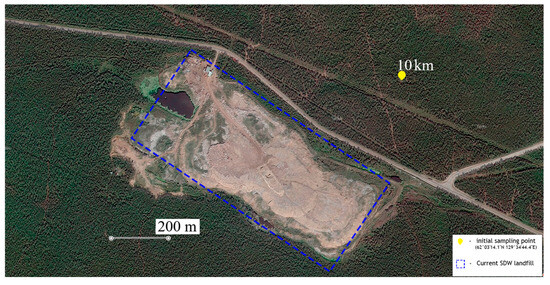
Figure 1.
General view of the landfill, where the initial sampling point is marked (10).
2.1. Study Area and Moss Sampling
Three species of mosses were selected as research subjects: Hylocomium splendens, Pleurozium Schreberi, and Brachythecium salebrosum. Sampling sites were selected at the 10th, 27th, 30th, and 51st km of the Vilyuisky tract from Yakutsk. The choice of moss sampling sites is conditioned by the fact that since the household waste landfill of Yakutsk is located at the 9th km along the Vilyuisky tract, it is necessary to study the dependence of heavy metal and radionuclide concentrations on the distance from the landfill to the sampling locations along this tract. It should be noted that the site at km 27 is the area of a new landfill. Figure 1 shows a general view of the landfill, which is located at km 9. Figure 2 shows a map of moss-biomonitor sampling locations along the Vilyuisky tract. At each site, mosses of three species were collected with an average volume of up to 0.02 m3.
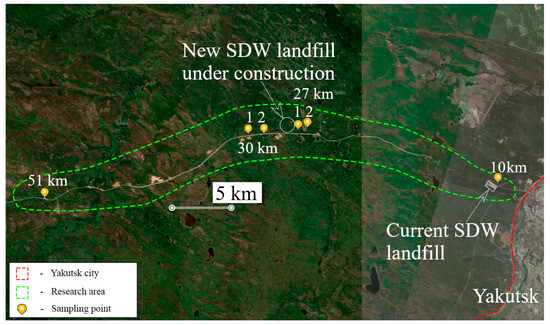
Figure 2.
Sampling map of moss biomonitors and soils along the Vilyui tract.
Mosses (Figure 3) were sampled in accordance with the UNECE ICP Vegetation methodology [20]. To determine the elemental composition of atmospheric deposition, green and green-brown segments of mosses corresponding to three-year growth were sampled (Figure 4).
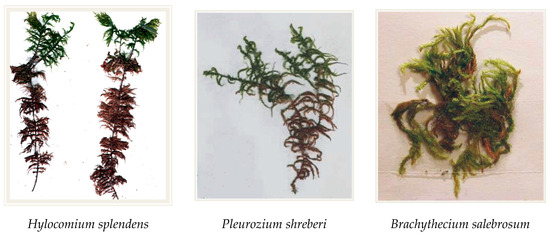
Figure 3.
Species of moss biomonitors growing in the sampling area.
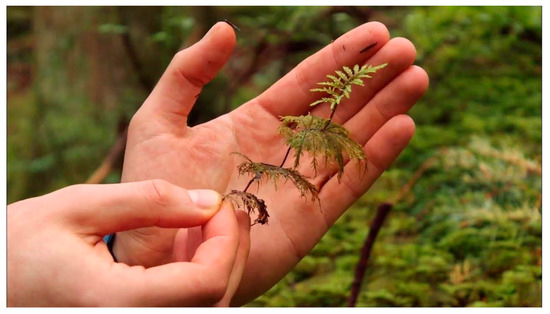
Figure 4.
The four annual segments (increases) that are used in the elemental analysis.
The moss was thoroughly cleaned from extraneous debris and soil residues. The cleaned samples were pulverized using a ball mill with agate cups (planetary monomill PULVERISETTE 6 classic line by Fritsch), then the obtained material was dried at 40 °C to constant weight.
2.2. Determination of Elemental Composition
The elemental composition of the moss samples was determined in the Frank Laboratory of Neutron Physics of the Joint Institute for Nuclear Research in Dubna by optical emission spectrometry with inductively coupled plasma (ICP-OES) PlasmaQuant PQ 9000 Elite (Analytik Jena, Jena, Germany) and a direct mercury analyzer DMA-80 evo Milestone. Then 0.5 g of moss was weighed on an analytical balance and placed in a Teflon vial with 5 mL of HNO3 and 2 mL of H2O2.
The samples were mineralized in a MARS6 microwave system (CEM, USA). After mineralization, the solutions were filtered through filter paper, transferred to 50 mL calibrated flasks and brought the volume to the mark with deionized water.
Three subsamples of each moss sample were analyzed. All in all, fifteen elements were determined: Al, Ba, Ba, Cd, Co, Co, Cr, Cr, Cu, Fe, Mn, Ni, P, Pb, S, Sr, V, and Zn. For mercury determination, 50 µg of the sample was weighed on an analytical balance and placed in a nickel cuvette for subsequent analysis on a direct mercury analyzer.
2.3. Quality Control of the Analyses
INCT-PVTL-6 (Tobacco leaves) standard was used for quality control of the analyses [21], see Table 1.

Table 1.
Results of analyzing the Virginia Tobacco Leaves standard [21].
2.4. Determination of Radionuclides
The determination of radioactive elements in moss samples was carried out in the Radiation Technology Laboratory of the Ammosov North-Eastern Federal University (NEFU) in Yakutsk. For this purpose, the moss samples were measured on a semiconductor gamma-spectrometer ‘ORTEK’ with a detector made of high purity germanium GEM-40 (SCGS).
Radionuclide concentration measurements by gamma-spectrometry were carried out without taking into account background values; however, it should be noted that when discussing the results of this study, the values of radionuclide concentration data at selected sampling points will be compared with the data obtained when studying the presence of radionuclides in uluses remote from Yakutsk.
The gamma-spectrometer was calibrated using 241Am and 152Eu standards to ensure sufficient measurement reliability. Before measurement, the samples were air-dried at room temperature for two months.
After drying at room temperature, the moss samples were dried in a muffle furnace at 250 °C for 2–3 h to a constant weight, then ground to a homogeneous powder.
After mass measurement, the ash was placed in a special vessel ‘Denta’. The radionuclide composition of the samples prepared in this way was measured using SCGS for 8–16 h. Gamma spectra were analyzed using Maestro-32 v7 software.
3. Results
3.1. Descriptive Statistics of Elemental Analysis
Table 2 presents the statistics (mean, standard deviation, median, minimum, maximum, and data scatter) obtained in the present study and the data obtained in the study of moss biomonitoring in Norway by ICP-OES method [22], as Norway is considered the least contaminated country in Europe.

Table 2.
Descriptive statistics of the concentration of heavy metals in moss samples (mg/kg).
A comparison of median values of element concentrations was carried out, which showed a significant excess of element concentrations in moss samples collected in the area near the landfill in Yakutsk compared to the median values of element concentrations in moss samples collected in Norway. The comparison of the results shows that there is a significant difference in median concentrations for the following elements: Al (1.2 times), Ba (2.3 times), Co (1.6 times), Cr (1.5 times), Fe (1.3 times), S (1.2 times), and lead Pb (24 times), which is consistent with the fact that the landfill contains a large amount of paper (Ba) and metal debris (Al, Co, Cr, Fe, Pb). The greater variation of the Norwegian data is explained by the geographical extent of the region; the maximum values correspond to the southern part, which is under the influence of long-range atmospheric transport of pollutants from Western Europe. From the obtained results, the following trend of accumulation of the investigated elements is observed in the landfill area: P > S > Al > Fe > Mn > Ba > Sr > Zn > Cu > Pb > Cr > Cr > V > Ni >Co > Cd > Hg.
As can be seen from Table 2, the comparison of the medians of the obtained values of Ba, Cr, Fe, and Pb content exceeds similar values for the conditionally “clean” territory of Norway (taking into account the fact that there is a ferro-chromium plant on its territory), which corresponds to the maximum values in the data scatter of the work [22].
In addition, the results of this study revealed that there is, for example, a decreasing concentration of lead, iron, aluminum, vanadium, and nickel depending on the distance between the landfill and the sampling point (Figure 5, Figure 6, Figure 7, Figure 8 and Figure 9), which may indicate that the sources of moss contamination may be the contents of the rubbish accumulated at the landfill. Red dots indicate the concentrations of lead and iron in moss samples collected on the territory of another district of the republic (Amginsky ulus), located at a distance of 200 km from Yakutsk. The graphs (Figure 5, Figure 6, Figure 7, Figure 8 and Figure 9) show that the values of TM concentration at 51 km are comparable to the values of TM concentration in Amga ulus.
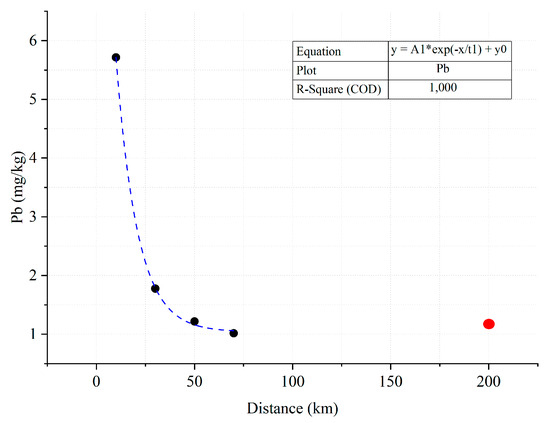
Figure 5.
Decreasing concentration of lead in moss with distance (km) from the landfill. The red dot corresponds to 200 km from Yakutsk.
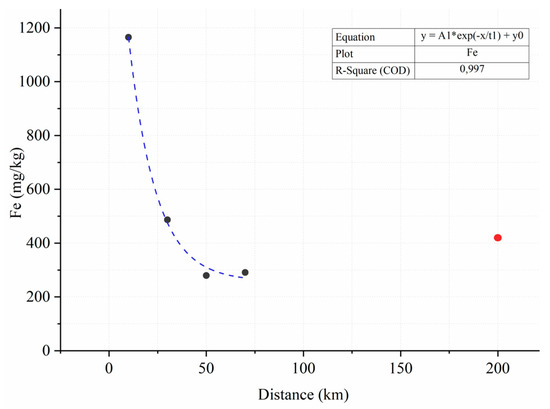
Figure 6.
Decreasing concentration of iron in moss with distance (km) from the landfill. The red dot corresponds to 200 km from Yakutsk.
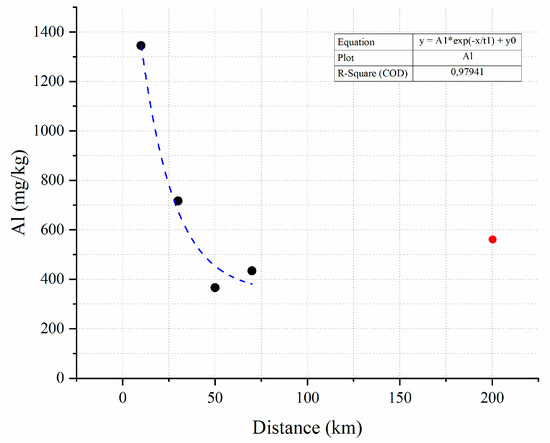
Figure 7.
Decreasing concentration of aluminum in moss with distance (km) from the landfill. The red dot corresponds to 200 km from Yakutsk.
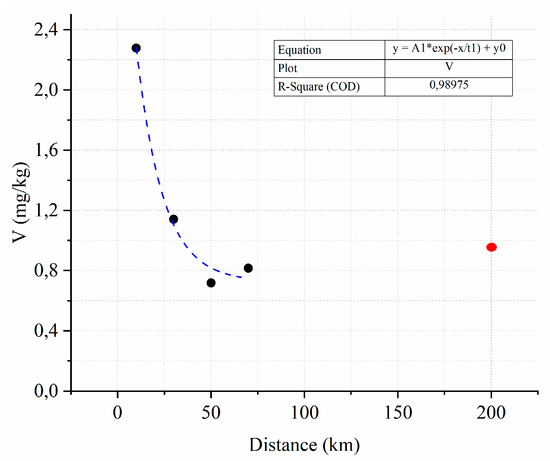
Figure 8.
Decreasing concentration of vanadium in moss with distance (km) from the landfill. The red dot corresponds to 200 km from Yakutsk.
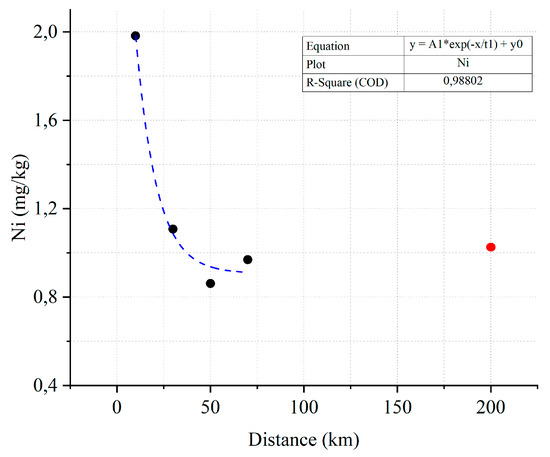
Figure 9.
Decreasing concentration of nickel in moss with distance (km) from the landfill. The red dot corresponds to 200 km from Yakutsk.
Table 3 presents the results of correlation analysis of the investigated elements. Pairy correlations are observed for almost all the defined metals.

Table 3.
Correlation analysis of elements obtained for the study area. High correlations are marked in red.
A particularly clear correlation with high correlation coefficients (marked in red) is observed for metals such as Fe-Cr, V-Ni, Hg-S, Pb-Cd, Fe-Pb, and Cd-Cu (Figure 10).
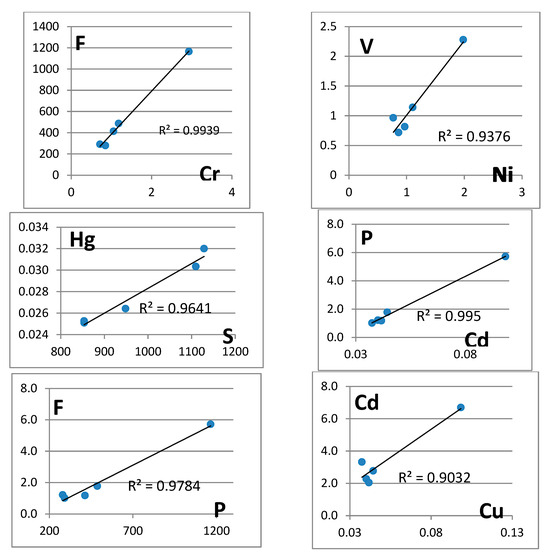
Figure 10.
Paired correlations of concentrations of a number of specific elements.
3.2. Radionuclide Analysis
According to the results of gamma-spectrometric analysis (Table 4), radionuclide 137Cs was detected in all samples. The highest value of caesium concentration was detected in the sample of moss Hyloconium splendens from the 51st km of the Vilyuisky tract. But at 10 km the 137Cs concentration is higher than at 27 km. That is, up to 27 km there is a decrease in caesium concentration, which may be due to the weakening of the influence of the SDW landfill as the distance from it increases. But at distances greater than 27 km, caesium concentration in moss samples increases, and the increase in concentration may be related to both the influence of the SDW landfill and other factors, which requires further study.

Table 4.
Specific activity of radionuclides (Bc/kg) in moss samples collected on the Vilyuysky tract.
The content of radiocaesium in the studied samples corresponds to the level of global radioactive fallout and is well below the permissible level (1000 Bq/kg). Cosmogenic radionuclide 7Be was also detected in the plant samples, the presence of which can be explained by prolonged precipitation during the sampling period. Radioisotopes of 212Pb, 208Tl, 212Bi, and 228Ac, daughter products of 223Th, are present in the studied samples. In addition, isotopes of 214Pb and 214Bi were detected, which are daughter products of 238U.
In addition to data on specific activity and 137Cs contamination of moss samples, Table 4 presents data on moss samples collected on the territory of Amginsky ulus. Comparison of specific activity and surface contamination with radiocaesium of the studied samples near Yakutsk and moss samples in Amginsky ulus shows that 137Cs concentration is several times higher in the moss samples on the territory near the Yakutsk landfill.
4. Discussion
The landfill for solid domestic waste disposal at the 9th km of the Vilyuisky tract has been in operation since 1967 and is the largest among solid domestic waste landfills in Yakutsk—its area is 31.8242 ha. Until the beginning of the 21st century, the main environmental pollutants were considered to be dust, carbon oxide and dioxide, sulfur and nitrogen oxides, hydrocarbons, phosphorus compounds, pesticides, radioactive isotopes, and the content of heavy metals and their compounds was not given due attention [23]. Currently, the attention of researchers is more focused on determining the concentration of heavy metals, for example, in atmospheric air.
Atmospheric pollution by increased amounts of chemical elements formed, for example, during fuel combustion and landfill burning occurs by spreading them in the form of suspended matter (SM) (smoke and dust). It is known that there is a dependence of mortality on the level of SM in atmospheric air [24]. According to the results of elemental analyses of dust and the soluble phase of snow cover samples conducted by the P.I. Melnikov Institute of Permafrost Science of the Siberian Branch of RAS, atomic emission and mass spectrometric methods revealed that on the territory of Yakutsk, the atmospheric air pollution with SM is two times higher on average compared to the sanitary norms, and radionuclides such as U and Th were detected in the snow cover [18].
Ultrafine particles (PM0.1), which are present in the air in large numbers, pose a health risk. They generally enter the body through the lungs but translocate to essentially all organs. Compared to fine particles (PM2.5), they cause more pulmonary inflammation and are retained longer in the lungs [25]. Their toxicity is increased with smaller size, larger surface area, adsorbed surface material, and the physical characteristics of the particles. Exposure to PM0.1 induces coughing and worsens asthma. Metal fume fever is a systemic disease of lung inflammation most likely caused by PM0.1. The disease is manifested by systemic symptoms hours after exposure to metal fumes, usually through welding. PM0.1 causes systemic inflammation, endothelial dysfunction, and coagulation changes that predispose individuals to ischemic cardiovascular disease and hypertension. PM0.1 is also linked to diabetes and cancer. PM0.1 can travel up the olfactory nerves to the brain and cause cerebral and autonomic dysfunction. Moreover, in utero exposure increases the risk of low birthweight. Although exposure is commonly attributed to traffic exhaust, monitored students in Ghana showed the highest exposures in a home near a trash burning site, in a bedroom with burning coils employed to abate mosquitos, in the home of an adult smoker, and in home kitchens during domestic cooking. The high point-source production and rapid redistribution make incidental exposure common, confound general population studies and are compounded by the lack of global standards and national reporting. The potential for PM0.1 to cause harm to health is great, but its precise role in many illnesses is still unknown and calls for more research.
According to the results of the study, the atmospheric dust of Yakutsk contains a large amount of sulfur, calcium, sodium, and iron oxides, and insignificant amounts of phosphorus, titanium, manganese, potassium, and aluminum oxides [18]. It has been observed that elements of third (Ba, V, W, Mn, Sr), second (B, Co, Ni, Mo, Cu, Sb, Cr) and first (As, Cd, Hg, Pb, Zn) toxicity classes are also present in the dust. In the report of this work, conducted in 2020, accumulations of elements Zn, Mn, Co, Ti, Ni, Ga, Sr, Zr, Sn, La were found in the surface atmosphere of Yakutsk in large particles PM10–100.
It was found that the concentration of Zn, Mn exceeds the maximum permissible values in soil. PM<10 particles contain Cu, Cd, Pb, Be, Y, Sc, Cr, where the content of metals Cu, Cd, Pb also exceeds the permissible values in soil. In addition, it was found that radionuclides are common in the atmospheric dust of the city.
The detection of heavy metals and radionuclides in moss samples during this research is consistent with the results of studies of atmospheric air in Yakutsk, conducted earlier by other methods [18]. Our research shows that the concentration of some heavy metals in moss samples exceeds the permissible concentration values (PCV) in soil. This indicates that the concentration of heavy metals in the soil of the sites along the Vilyui tract from which moss was collected for the present study will be higher than the PCV in soil [26]. In the present study, Cr (concentration above PCV), Ni and Zn (concentration above PCV) were also found among the heavy metals. These metals are usually found in vegetation near the industrial sites of mining and processing plants (MPPs). From recent work, it is known that there is an increase in heavy metals in soil and vegetation in adjacent areas as a result of mining. For example, shrubs growing at the industrial site of Udachninsky GOK (Yakutia, Russia) accumulate high levels of heavy metals, namely Cr, Ni, and Zn [27]. High values of these metal concentrations along the Vilyuisky tract (where only a solid domestic waste landfill is located and there are no industrial enterprises) are comparable to the values of heavy metal concentrations formed during the operation of the mining and processing plant in the vegetation growing in the nearby territory of mining and processing plants.
Our study of TM concentration is of a pioneer character: for the first time the moss biomonitor method was applied to the assessment of atmospheric deposition of TM, including mercury. The mass fraction of mercury determined in this work is extremely low and varies in the range of 0.024–0.032 mg/kg. The comparison of the mercury contamination level of the Vilyui tract territory of Yakutia is much lower than the levels presented in the works [9,10,11]. A comparison of the mass fraction of mercury in moss samples near the landfill of Yakutsk and conditionally clean Norway (0.005–0.530 mg/kg) shows that the specific concentration of mercury in biomonitor moss samples collected on the Vilyuisky tract of the Republic of Sakha (Yakutia) is two times less than in the Norwegian samples. Therefore, we do not consider it necessary to emphasize this element, taking into account that we are dealing with domestic, not industrial waste.
Table 4 presents the results of the study of 137Cs concentration in moss samples collected on the territory of the Amga ulus of the Republic of Sakha (Yakutia). Comparison of specific radiocaesium activities of moss samples near the landfill in Yakutsk and moss samples in Amginsky ulus shows that 137Cs concentration is several times higher in moss samples from the territory near the landfill in Yakutsk than in moss samples from Amginsky ulus.
In studies of vegetation samples in the Lena–Amga interfluve and taiga-meadow landscapes of the Vilyui River basin conducted in [28], the presence of 137Cs in moss and lichen samples was detected. The range of this radionuclide concentration values was from 1 ± 0 to 36 ± 2 Bq/kg in the Lena–Amga interfluve and 21 ± 1 to 36 ± 3 Bq/kg in the Vilyui River basin.
Comparison of these data with the results of our study shows that in samples taken along the Vilyui tract, the content (concentration) of radiocaesium, the range of values of which varies from 3 ± 1 to 63 ± 2 Bq/kg, significantly exceeds the range of the study data [28]. Such values require further investigation and data analysis to identify sources of contamination. One of the sources of contamination with heavy metals and radionuclides may be a landfill for solid domestic waste disposal.
In addition, the results of this study confirm data from the Federal Service for Supervision of Natural Resources Management in 2020 [29]. At this landfill, a total of 460,000 tons of waste were deposited at the established design capacity of 450,000 tons, i.e., the landfill was already overfilled in 2020, and at the end of 2021, the overfilling of waste was already 135,178.3 tons, and it continues to accumulate. As a result of smoldering (incineration) of waste in the collected samples of atmospheric air, the excess of sulfur dioxide SO2 for urban and rural settlements was found to be almost 10 times above permissible. Along with this, facts of illegal reception and burial of prohibited waste, such as office equipment, household appliances (monitors, TV sets, computers, cartridges, refrigerators, microwave ovens, etc.), tires, black and non-ferrous metal, etc., as well as waste subject to recycling (paper, cardboard, polymeric materials, metals, etc.), which includes heavy metals and other toxic substances, have been established.
5. Conclusions
The moss biomonitoring method was first applied to assess the atmospheric deposition of heavy metals and other toxic elements, as well as radionuclides along the Vilyuisky tract, 9 km of which is a SDW landfill in Yakutsk, Republic of Sakha (Yakutia), Russia.
The study of moss samples by ICP-OES showed that the landfill contains large amounts of paper (Ba) and metal debris (Cr, Fe, Pb). Comparison of the mean values of Ba, Cr, Fe, and Pb showed that they were higher than in the conditionally “clean” area of Norway. The high concentration values of these heavy metals in moss samples from areas adjacent to the city (near the landfill) are comparable to the concentration values of heavy metals in vegetation samples from locations near, for example, the industrial sites of mining and processing plants [27]. Detection of the same heavy metals and radionuclides in the atmosphere, in vegetation near the dump and further along the Vilyuisky tract may indicate that one of the sources of environmental pollution may be products of the contents of the dump at 9 km of the Vilyuisky tract.
One of the sampling points is the 27th kilometer of the Vilyuisky tract. A new landfill in Yakutsk on a 46 ha site at km 27 of the Vilyuisky tract is planned to be commissioned in the coming years [30]. The results obtained from samples collected at this location can serve as baseline data for similar studies for future monitoring of the environmental impact of the landfill in the immediate vicinity of this site.
Similar studies are necessary to monitor and improve the environment in order to realize plans to increase life expectancy in Yakutia to 80 years by 2030, as stated by the Head of the Republic of Sakha (Yakutia), Aisen Nikolaev, in his address to the State Assembly (Il Tumen).
The results of this study show the need to introduce technologies for sorting, recycling, and proper waste disposal; the landfill impact zone can be significantly reduced by introducing new technologies for waste disposal and sorting in permafrost conditions, extreme temperature conditions and taking into account the geographically remote location of Yakutsk from other Russian regions with more developed infrastructure.
Author Contributions
Conceptualization, M.F. and S.M.; methodology, M.F. and S.M.; formal analysis, M.F., S.M., K.P., V.K. (Vassiliy Kolodeznikov), G.I., V.K. (Vladlen Kononov) and E.Z.; investigation, M.F., S.M., K.P., V.K. (Vassiliy Kolodeznikov), G.I., V.K. (Vladlen Kononov) and E.Z.; data curation, M.F., S.M., K.P. and V.K. (Vladlen Kononov); writing—review and editing, M.F., S.M. and K.P.; visualization, M.F., S.M., K.P. and V.K. (Vladlen Kononov); supervision, M.F. and S.M.; funding acquisition, M.F. and S.M. All authors have read and agreed to the published version of the manuscript.
Funding
This research received no external funding.
Institutional Review Board Statement
Not applicable.
Informed Consent Statement
Not applicable.
Data Availability Statement
Data are published in the paper.
Conflicts of Interest
The authors declare no conflicts of interest.
References
- Main Causes of Cancer. Available online: https://oncology.ru/specialist/prophylaxis/causes/ (accessed on 23 April 2025).
- Cancer Risk Factors. Available online: https://profilaktica.ru/for-population/profilaktika-zabolevaniy/onkologiya/faktory-riska-razvitiya-raka/ (accessed on 23 April 2025).
- Alimam, W.; Auvinen, A. Cancer risk due to ingestion of naturally occurring radionuclides through drinking water: A systematic review. Sci. Total Environ. 2025, 968, 178849. [Google Scholar] [CrossRef]
- Laniyan, T.A.; Adewumi, A.J. Health risk profile of natural radionuclides in soils, sediments, tailings and rocks around mining sites in Nigeria. Environ. Earth Sci. 2021, 80, 375. [Google Scholar] [CrossRef]
- Choi, T.A.; Costes, S.V.; Abergel, R.J. Understanding the Health Impacts and Risks of Exposure to Radiation. In Reflections on the Fukushima Daiichi Nuclear Accident; Ahn, J., Carson, C., Jensen, M., Juraku, K., Nagasaki, S., Tanaka, S., Eds.; Springer: Cham, Switzerland, 2015. [Google Scholar] [CrossRef]
- Jaishankar, M.; Tseten, T.; Anbalagan, N.; Mathew, B.B.; Beeregowda, K.N. Toxicity, mechanism and health effects of some heavy metals. Interdiscip. Toxicol. 2014, 7, 60–72. [Google Scholar] [CrossRef]
- Jomova, K.; Alomar, S.Y.; Nepovimova, E.; Kuca, K.; Valko, M. Heavy metals: Toxicity and human health effects. Arch. Toxicol. 2025, 99, 153–209. [Google Scholar] [CrossRef] [PubMed]
- Schiavo, B.; Meza-Figueroa, D.; Vizuete-Jaramillo, E.; Robles-Morua, A.; Angulo-Molina, A.; Reyes-Castro, P.A.; Inguaggiato, C.; Gonzalez-Grijalva, B.; Pedroza-Montero, M. Oxidative potential of metal-polluted urban dust as a potential environmental stressor for chronic diseases. Environ. Geochem. Health 2023, 45, 3229–3250. [Google Scholar] [CrossRef] [PubMed]
- Schiavo, B.; Meza-Figueroa, D.; Morton-Bermea, O.; Vizuete-Jaramillo, E.; Robles-Morua, A. Seasonal variation of mercury in settled dust from brick kiln pollution in Sonora, Mexico: Ecological risk and human health implication. Atmos. Pollut. Res. 2023, 14, 101787. [Google Scholar] [CrossRef]
- Liu, S.; Wang, X.; Guo, G.; Yan, Z. Status and environmental management of soil mercury pollution in China: A review. J. Environ. Manag. 2021, 277, 111442. [Google Scholar] [CrossRef] [PubMed]
- Qu, R.; Han, G.; Liu, M.; Li, X. The Mercury Behavior and Contamination in Soil Profiles in Mun River Basin, Northeast Thailand. Int. J. Environ. Res. Public Health 2019, 16, 4131. [Google Scholar] [CrossRef] [PubMed]
- Rouhani, A.; Hejcman, M. A review of soil pollution around municipal solid waste landfills in Iran and comparable instances from other parts of the world. Int. J. Environ. Sci. Technol. 2024, 22, 9711–9728. [Google Scholar] [CrossRef]
- Huang, Z.; Liu, G.; Zhang, Y.; Yuan, Y.; Xi, B.; Tan, W. Assessing the impacts and contamination potentials of landfill leachate on adjacent groundwater systems. Sci. Total Environ. 2024, 930, 172664. [Google Scholar] [CrossRef] [PubMed]
- Environmental Problems of Yakutsk. Available online: https://smekni.com/a/329319/ekologicheskie-problemy-yakutska/ (accessed on 29 June 2023). (In Russian).
- Pakhomov, A.A.; Fedorova, E.Y. Environmental pressures on Yakutsk and counteraction measures. In Sustainable North: Society, Economics, Ecology, Politics: Proceedings of the VI All-Russian Scientific and Practical Conference, Yakutsk, Russia, 29 September 2021; Grigorieva, E.E., Ed.; Northeastern Federal University named after M. K. Ammosov: Yakutsk, Russia, 2021; pp. 211–215, EDN UUOJXP. (In Russian) [Google Scholar]
- Chemezov, E.N.; Sosina, S.A. The State of the Atmosphere of the Republic of Sakha (Yakutia); Symbol of Science, 2017; № 1. Available online: https://cyberleninka.ru/article/n/sostoyanie-atmosfery-respubliki-saha-yakutiya (accessed on 3 November 2023).
- Residents of Yakutsk Will Be Able to Donate Garbage to the Municipal Landfill. SakhaNews. Available online: https://1sn.ru/ziteli-yakutska-smogut-sdavat-musor-na-gorodskoi-poligon-otxodov (accessed on 3 November 2023).
- Scientific and Technical Report “Origin and Composition of Dust in the Territory of the Yakutsk Municipality”. Available online: https://sinetspark.org/dust_in_yakutsk/tpost/itp1oh7n91-zaversheno-nauchnoe-issledovanie-prichin (accessed on 4 July 2023). (In Russian).
- UNECE ICP Vegetation. Available online: https://icpvegetation.ceh.ac.uk/ (accessed on 11 December 2024).
- ICP Vegetation. Moss Manual-2020. Available online: https://icpvegetation.ceh.ac.uk/get-involved/manuals/moss-survey (accessed on 5 July 2023).
- Labmix24. Polish Virginia Tobacco Leaves. Available online: https://labmix24.com/en/products/IC-INCT-PVTL-6 (accessed on 20 January 2024).
- Steinnes, E.; Uggerud, H.T.; Pfaffhuber, K.A.; Berg, T. Atmospheric Deposition of Heavy Metals in Norway. National Moss Survey 2015; NILU Rapport: Kjeller, Norway, 2017. [Google Scholar]
- Avtsyn, A.P.; Zhavoronkov, A.A.; Marachev, A.G.; Milovanov, A.P. Human Pathology in the North; Meditsina Publ.: Moscow, Russia, 1985; 415p. (In Russian) [Google Scholar]
- Golikov, R.A.; Surzhikov, D.V.; Kislitsyna, V.V.; Steiger, V.A. The impact of environmental pollution on public health (literature review). Sci. Rev. Med. Sci. 2017, 5, 20–31. [Google Scholar]
- Schraufnagel, D.E. The health effects of ultrafine particles. Exp. Mol. Med. 2020, 52, 311–317. [Google Scholar] [CrossRef] [PubMed]
- Maximum Permissible Concentrations of Chemicals in the Soil: Hygienic Standards; Federal Center of Hygiene and Epidemiology of Rospotrebnadzor: Moscow, Russia, 2006; p. 15. (In Russian)
- Gololobova, A.; Legostaeva, Y. Potentially toxic elements uptake and distribution in Betula middendorffii T. and Duschekia fruticosa R. growing on diamond mining area (Yakutia, Russia). Plants 2024, 13, 2440. (In Russian) [Google Scholar] [CrossRef] [PubMed]
- Yakovleva, V.D.; Stepanov, V.E. Radioecological Problems of Peaceful Underground Nuclear Explosions in Yakutia; Sputnik+: Moscow, Russia, 2013; 128p. (In Russian) [Google Scholar]
- What Secrets Does the Yakutsk Landfill on the Vilyuysky Tract Hide? Available online: https://1sn.ru/index.php/kakie-tainy-skryvaet-svalka-yakutska-na-vilyuiskom-trakte (accessed on 4 November 2023). (In Russian).
- The New Yakutsk Landfill Will Begin Receiving Waste in 2024. Available online: https://yakutia-daily.ru/novyj-musornyj-poligon-yakutska-nachnet-prinimat-othody-v-2024-godu/ (accessed on 24 April 2024). (In Russian).
Disclaimer/Publisher’s Note: The statements, opinions and data contained in all publications are solely those of the individual author(s) and contributor(s) and not of MDPI and/or the editor(s). MDPI and/or the editor(s) disclaim responsibility for any injury to people or property resulting from any ideas, methods, instructions or products referred to in the content. |
© 2025 by the authors. Licensee MDPI, Basel, Switzerland. This article is an open access article distributed under the terms and conditions of the Creative Commons Attribution (CC BY) license (https://creativecommons.org/licenses/by/4.0/).